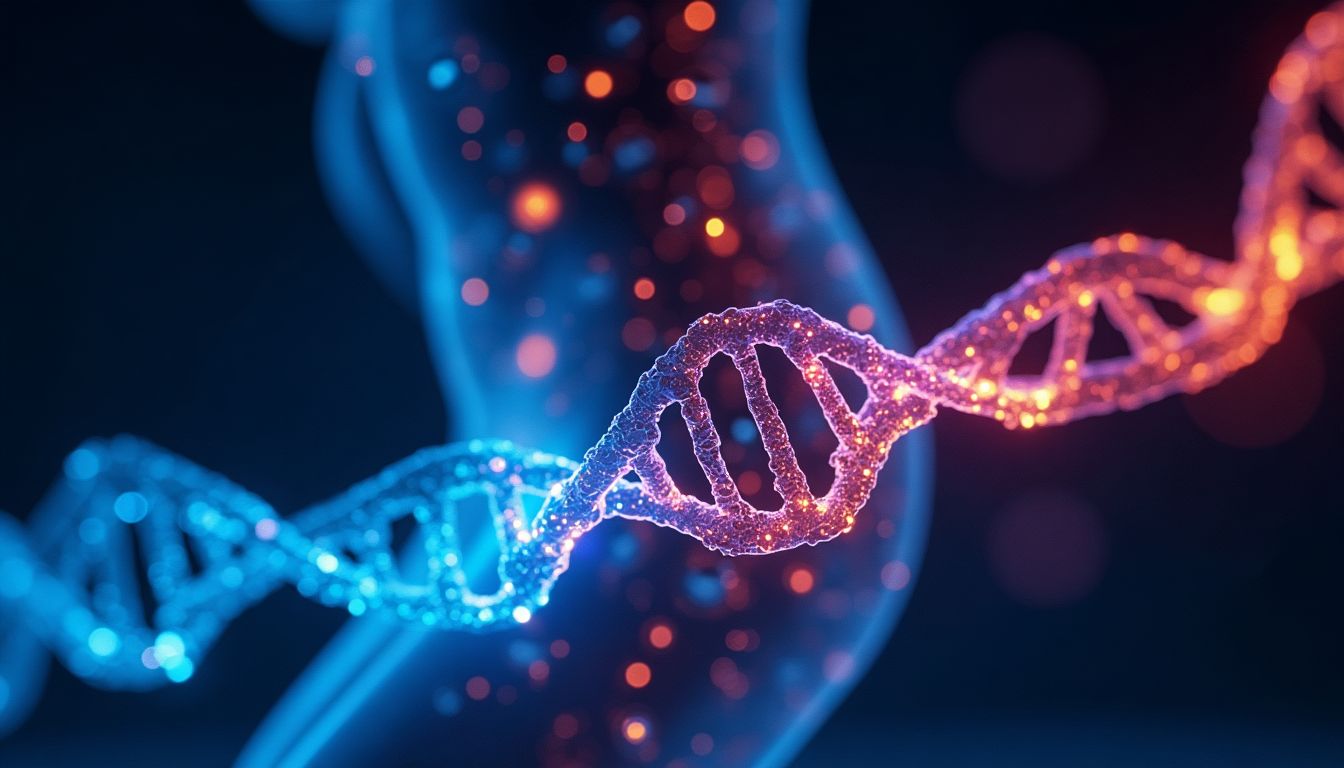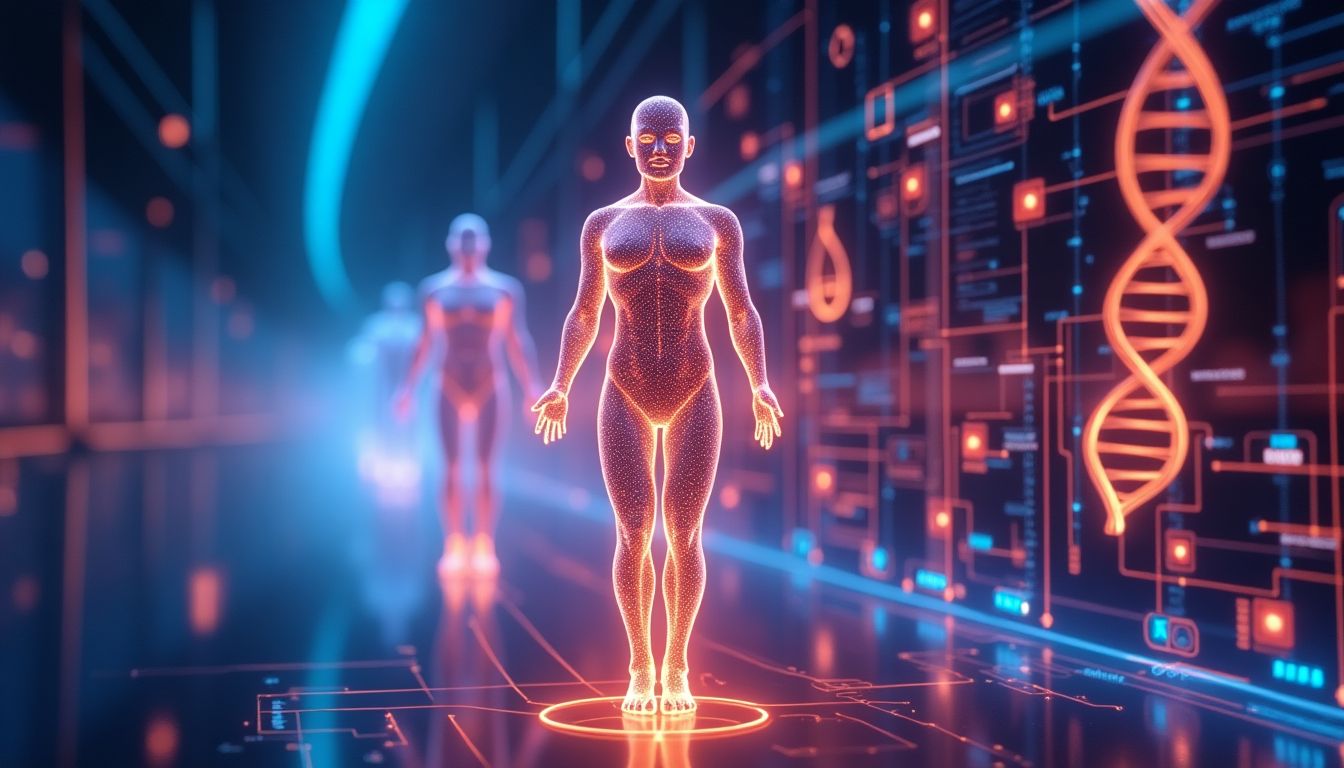Introduction: The Future of Body Transformation
In the end, we only regret the chances we didn’t take. - Lewis Carroll. This little gem serves as a reminder that in our quest for the perfect body, many of us have turned to extreme diets, horrific gym routines, and workout classes that can only be described as torture. Biosculpting, however, flips the narrative on its head. Instead of drilling ourselves into submission with a kale chip in one hand and a dumbbell in the other, we might soon rely on genetic technology to achieve our desired physique. Can you imagine? Instead of plodding on a treadmill, all we might need is a simple tweak in our genes! This lead us to some serious existential questions: What if body sculpting became a matter of pressing a button instead of breaking a sweat? As we unearth the potential of biosculpting, we embark on an exciting journey through a world where traditional modes of weight management may become relics of the past.
Notably, influential figures such as George Church, a prominent geneticist, have been vocal about the future of genetic engineering. Erwin Chargaff, whose work laid the groundwork for DNA research, would likely marvel at the implications of this technology. Then there's the modern-day futurist, Ray Kurzweil, whose predictions have often included the merging of technology and biology. These pioneers speak to the reality that we are on the verge of a breakthrough that could change everything about how we view health and aesthetics.
1. The Science Behind Biosculpting
This section delves into the foundational biology and genetic mechanisms that empower biosculpting. At its core, biosculpting utilizes the powerful tool of CRISPR technology, which can precisely alter genes. This means scientists can tinker with our DNA much like a programmer debugs a souped-up computer software. Imagine a world where instead of sweating bullets at the gym and starving ourselves at the dinner table, we could simply adjust our genetic makeup. Sounds like science fiction? Well, welcome to the future!
1.1 Gene Modification Techniques
In this part, we dive a bit deeper to uncover how specific genes relate to our metabolism and fat storage. For instance, researchers have discovered particular genetic markers that play a key role in how our bodies store fat. By modifying these genes, scientists aim to create a metabolic environment conducive to weight loss. It’s like swapping out the batteries in a toy – suddenly, everything works much more efficiently!
1.2 Metabolic Engineering
This is where the magic happens! Metabolic engineering looks at how we can enhance the body's ability to burn energy and oxidize fat. Imagine being able to ramp up your fat-burning machinery while you binge-watch your favorite show on the couch! Studies show that tweaking our metabolism could lead to significant impacts on weight loss and maintenance. So, while our peers slog it out at overpriced spinning classes, we might be chilling, genetically modifying our body's engines for peak performance.
2. Historical Context and Evolution of Body Sculpting
Body sculpting isn't exactly a new idea. People have been trying to enhance their looks for thousands of years. From ancient rituals to modern science, our quest for physical perfection has transformed remarkably. Let’s take a trip down memory lane and explore how we've come to biosculpting today—a high-tech solution for age-old vanity!
2.1 Ancient Practices
Think about traditional weight loss methods: exercise, herbal remedies, and the occasional extreme dieting. Ancient Egyptians were known to use a mix of exercise and special diets to achieve their golden era physique. Some even starved themselves in the name of beauty—yikes! If only Cleopatra had the option of biosculpting instead! You can learn more about ancient beauty standards in this interesting piece on Wikipedia.
2.2 Modern Developments
Fast-forward to today, and we have science on our side! With breakthroughs in biotechnology and genetics, we’re moving to a whole new level of body enhancement. Your dream body is closer than ever. Technologies like CRISPR have made it feasible to modify genes and tackle weight issues at their root. Traditional exercise and dieting may still work for some people, but wouldn’t it be nice if you could just cut to the chase and sculpt your body the way you want? Plus, let’s admit it—trips to the gym aren’t always a walk in the park (unless you're power walking!).
3. Ethical Considerations of Biosculpting
With great power comes great responsibility, and biosculpting is no exception. While we’re excited about the possibilities, we must also tread carefully. Let’s dive deep into the murky waters of ethical dilemmas surrounding genetic modification. What does it mean for society? Can you say “slippery slope”? Here, we explore the moral maze that comes with biosculpting.
3.1 Ethical Dilemmas
Will biosculpting create a new form of genetics-based discrimination? Imagine a world where your weight-loss journey is measured by your genetics instead of willpower. How would that make you feel? Almost like not knowing if you’ve got a job in the family business or are destined for greatness! Here’s the good news: there's a whole lot of debate happening, and various organizations are stepping up to define what 'normal' should look like. This research article dives into some serious questions about what biosculpting could mean for our society. Spoiler alert: it’s a heavy topic.
3.2 Regulatory Challenges
Now, let’s consider the rules of the road. Are we ready for a world where your gym buddy could be a genetically-modified superhuman? Yeah, that might be a leap. It’s important to have proper regulations in place before diving into the biosculpting pool. Organizations like the FDA are tasked with keeping an eye on these technologies to ensure everyone's safety. So while we explore fancy new ways to get fit, we also need someone ensuring that we don’t accidentally turn ourselves into glow-in-the-dark beings. Let's keep our humanity intact while snatching those curves!
4. Societal Impacts of Instant Body Modification
The arrival of biosculpting as a mainstream method of body modification will undeniably change how we see health and beauty. Imagine living in a world where everyone can readily achieve their dream body, but at what cost? In this section, we’ll take a closer look at the potential social ramifications of biosculpting and how it might redefine our views on health, fitness, and aesthetics.
4.1 Changing Beauty Standards
The introduction of biosculpting could send shockwaves through the concept of beauty. Today, beauty standards are often dictated by popular culture, social media, and fleeting trends. With biosculpting, however, those standards may shift dramatically.
Here’s a quick look at how biosculpting could change beauty norms:
- Inclusivity: If everyone has access to biosculpting, physical attributes like muscle tone or body shape may become less significant.
- Variety: Cultures that celebrate diverse body types could see their ideals gaining traction rather than being overshadowed by one dominant beauty standard.
- Perception of Natural Beauty: There may be a potential backlash against those who choose not to undergo biosculpting, leading to debates about what constitutes “natural” beauty.
As we navigate these changes, it’s crucial to consider how biosculpting may foster acceptance or create new societal challenges.
4.2 Public Health Implications
One of the most exciting potential benefits of biosculpting is its impact on public health. If people can modify their bodies to achieve optimal health, this could lead to fewer cases of obesity and related diseases. As we can see in the table below, the current health crisis is staggering:
| Health Issue | Current Statistics |
|---|---|
| Obesity in Adults | 42.4% of adults in the U.S. are considered obese (CDC). |
| Type 2 Diabetes | Nearly 34 million Americans live with diabetes, 90-95% of which are Type 2 (CDC). |
| Heart Disease | About 697,000 Americans die from heart disease each year (CDC). |
By modifying genes related to fat storage or metabolism, biosculpting may serve as an explicit preventive measure against these pressing health issues.
5. The Future of Fitness: Biosculpting and Beyond
As we wrap up our discussion on biosculpting, it’s fascinating to envision what the future of body modification and fitness might look like. Combine biosculpting with other technological innovations, and you get an enticing world of possibilities for maintaining health and wellness.
5.1 Integrative Approaches
As more people consider biosculpting, it’s essential to think about how it can integrate with other advancements in health and wellness technology. Here are a few ways these technologies could work together:
- Wearable Fitness Trackers: Devices like the Fitbit can provide real-time data on personal health metrics, guiding users after they undergo biosculpting.
- Personalized Nutrition: Diet apps, such as MyFitnessPal, can help tailor nutritional needs and make smart food choices post-modification.
- Telehealth Services: Online health consultations can complement biosculpting, allowing professionals to monitor patient progress and health outcomes through a virtual platform.
5.2 The New Health Paradigm
Ultimately, the combination of biosculpting and innovative technologies may steer us toward a culture built around genetic wellness and preventive health. This could lead to:
- An emphasis on genetic understanding: People might become more aware of the genetic factors that impact their health, leading to healthier lifestyle choices.
- Increased accessibility: As biosculpting technologies develop and become mainstream, health resources may become more equitable across different socioeconomic groups.
- Transformation of healthcare: Medical interventions may shift from reactive to proactive, with genetics playing a crucial role in health maintenance.
The future brims with opportunity. As we stand at the crossroads of technology and our personal journeys toward health and fitness, it's essential to remain vigilant about ethical practices and societal implications.
6. AI Solutions: How Would AI Tackle This Issue?
Artificial Intelligence (AI) offers remarkable possibilities for revolutionizing biosculpting. As we delve into AI's capabilities, we can envision solutions that refine research processes, improve genetic editing, and encourage public acceptance of biosculpting. By harnessing the potency of vast datasets, AI has the potential to transform how we approach genetic modification.
6.1 AI in Genetic Research
AI-driven advancements will significantly accelerate genomic research. Using machine learning algorithms, researchers can analyze complex genetic interactions and identify potential gene targets for biosculpting. For instance, institutions like Janelia Research Campus have been using AI to understand neuronal circuits, which may provide insights transferable to gene functions related to metabolism and fat storage. By integrating AI into genomic studies, researchers can pinpoint mutations with the highest likelihood of enhancing fat loss while minimizing risks.
6.2 Predictive Modelling
One of the most exciting aspects of AI's application in biosculpting lies in predictive modeling. Sophisticated AI models can analyze individual genetics and lifestyle data to forecast how a person might respond to specific biosculpting treatments. For example, organizations like 23andMe utilize genetic data to present health risk information. By expanding such analysis to biosculpting, individuals could receive tailored recommendations based on unique genetic markers that correlate with successful outcomes. This customization allows for a more personalized approach, making treatments both safe and effective.
6.3 Potential Collaborations
Integrating AI seamlessly into biosculpting will require collaborative efforts across interdisciplinary fields. Leading tech companies, research institutions, and biotech firms will need to partner strategically. Organizations like Abbott, known for their advancements in health technology, could collaborate with geneticists and data scientists to create innovative biotechnological solutions that push boundaries.
Action Schedule/Roadmap (Day 1 to Year 2)
Day 1: Formation of Multidisciplinary Teams
Assemble diverse teams of geneticists, AI experts, ethicists, and data scientists, integrating their expertise to address biosculpting holistically.
Day 2: Develop Initial Research Framework
Establish research priorities and specify genetic targets through literature reviews and consultations with bioethicists, ensuring all approaches align with current scientific standards.
Day 3: Ethical Compliance Setup
Submit proposals for institutional review board (IRB) approval, followed by the establishment of ethical frameworks guiding future biosculpting research.
Week 1: AI Training and Parameters Definition
Initiate processes to train AI algorithms using historical data from genetic studies, setting parameters for predictive modeling to ensure accuracy and reliability.
Week 2: Pilot Study Design
Design pilot studies around selected genetic modifications, ensuring the methodologies leverage AI insights for precise experimental control.
Week 3: Partner Outreach
Develop partnerships with universities, organizations, and biotech companies experienced in genetic research, including institutions like MIT and Harvard University.
Month 1: Initiating Pilot Studies
Begin preliminary pilot studies incorporating AI tools for data collection and analysis for the participating subjects, documenting results comprehensively.
Month 2: Data Analysis and Adjustment
Analyze data gathered from pilot studies using AI, adjusting protocols as necessary based on feedback and statistical significance.
Month 3: Expanded Collaboration
Expand collaborations to encompass global research networks, maximizing resources through initiatives like the WHO.
Year 1: Broader Multinational Trials
Commence more extensive clinical trials involving diverse population groups across multiple countries, ensuring the varied representation of genetics.
Year 1.5: Longitudinal Impact Studies
Begin longitudinal studies to track the impact of biosculpting over time, employing AI for predictive modeling in response to real-life scenarios and adjustments in lifestyle.
Year 2: Results Submission and Regulatory Discussions
Prepare comprehensive results for regulatory agencies, ensuring compliance with evolving legislation and the integration of findings into future biosculpting technologies.
Conclusion: The Promise and Peril of Biosculpting
Biosculpting stands as both a beacon of hope and a subject for caution as we explore the intersection of genetics and body transformation. While this revolutionary technology can help reshape societal norms of beauty and health, we must tread carefully to navigate the ethical implications that accompany its implementation. The balance between progress and moral responsibility will dictate whether biosculpting becomes a tool for empowerment or a harbinger of genetic inequality. Therefore, as we peer into the future, it’s essential to foster a dialogue promoting understanding, safety, and equitable access to these groundbreaking technologies. Setting the stage for responsible use can help ensure that our collective pursuit of aesthetic and health improvements does not impede the essential human values of empathy, connection, and diversity. As we advance towards this promising horizon, the question arises: How can society ensure that innovative technologies serve to unite us rather than divide us?
FAQ
What is biosculpting?
Biosculpting is a modern technique that uses genetic technologies to change the way our bodies look, allowing for quick weight loss and improvements in physical appearance. It can be thought of as a cutting-edge way to “sculpt” the human body at the genetic level.
Is biosculpting safe?
The safety of biosculpting varies based on the methods used and ongoing advancements in regulations. Currently, research and testing are crucial to ensure that any genetic modifications made through biosculpting are safe for people. Scientists are working hard to establish safety protocols to protect everyone involved.
How does AI contribute to biosculpting?
Artificial Intelligence (AI) plays a key role in biosculpting by:
- Speeding Up Research: AI can analyze vast amounts of data quickly, helping scientists find the best ways to modify genes.
- Predicting Outcomes: AI models can predict how different bodies will react to modifications, allowing for more personalized approaches to treatment.
- Improving Techniques: By analyzing the results of experiments, AI helps refine and enhance genetic editing methods.
Will biosculpting eliminate the need for exercise?
While biosculpting offers exciting possibilities for body transformation, it is not meant to replace exercise. Regular physical activity is essential for overall health, emotional well-being, and maintaining a balanced lifestyle. Combining biosculpting and exercise could produce the best outcomes for fitness and health.
What are the ethical concerns related to biosculpting?
Biosculpting raises several ethical questions, including:
- Genetic Inequality: There's a risk that not everyone will have access to these technologies, creating a divide based on wealth.
- Defining 'Normal': What becomes accepted as the 'ideal' body shape and size could shift, causing societal pressure to conform to new beauty standards.
- Consent and Autonomy: It’s important to ensure that individuals who undergo these changes fully understand the risks and implications of modifying their genes.
How do we ensure ethical use of biosculpting technology?
To promote ethical practices in biosculpting, we need strong regulatory frameworks. Scientists, ethicists, and policymakers should work together to create guidelines that keep biosculpting safe, fair, and respectful of individual rights. Regular discussions and engagements, like those at organizations such as National Human Services, can help shape these frameworks.
Can biosculpting change cultural perceptions of beauty?
Yes, biosculpting could significantly influence how cultures see beauty. As people opt for genetic modifications to achieve their desired appearance, it might shift societal norms and expectations regarding body image. This could lead to a more diverse understanding of beauty, as different body types and modifications become normalized.
What potential benefits might biosculpting have on public health?
Biosculpting could have several public health benefits, such as:
- Reducing Obesity Rates: By providing a way to manage weight more effectively, it could help combat obesity, leading to reduced risk of diseases.
- Enhancing Physical Well-Being: People who feel good about their appearance are more likely to engage in healthy activities, contributing to overall better health.
- Shifting Health Paradigms: It could lead to a focus on genetic wellness, encouraging preventative measures rather than reactive healthcare.
How can someone learn more about biosculpting?
To dive deeper into biosculpting, consider exploring reputable resources like academic publications, health organization websites, and scientific blogs. Engaging discussions on platforms such as LinkedIn can connect you with professionals in the field, and following updates from institutes like HHS Office for Civil Rights can keep you informed on the latest developments.
Wait! There's more...check out our gripping short story that continues the journey: The Beacon
Disclaimer: This article may contain affiliate links. If you click on these links and make a purchase, we may receive a commission at no additional cost to you. Our recommendations and reviews are always independent and objective, aiming to provide you with the best information and resources.
Get Exclusive Stories, Photos, Art & Offers - Subscribe Today!





























Post Comment
You must be logged in to post a comment.